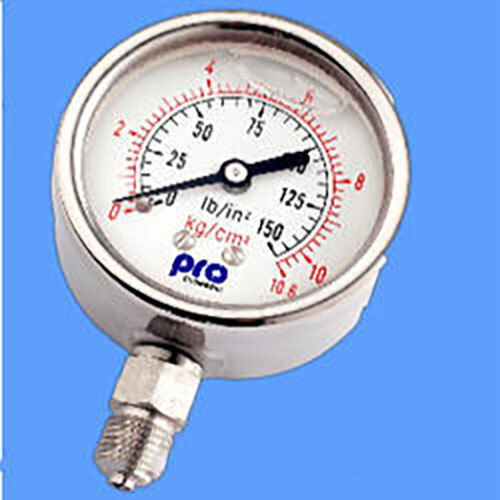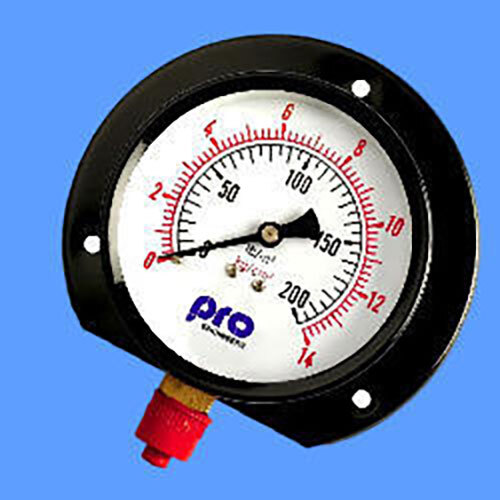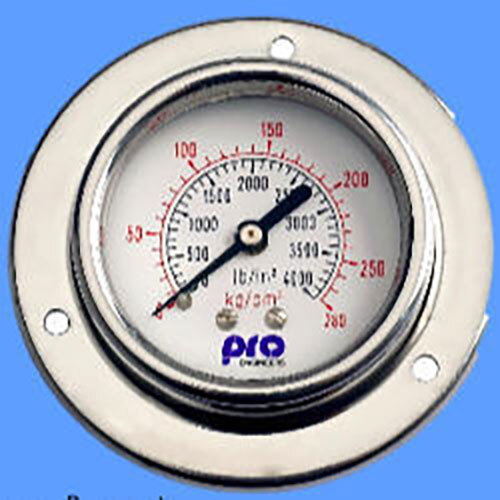Glycerin Filled Pressure Gauge
Product Details:
- Display Analog
- Usage Air compressors, Hydraulic systems, Pumps, Industrial & Marine engines
- Size 63, 100, 150
- Product Type Glycerin Filled Pressure Gauge
- Accuracy 1.6% of FSD %
- Click to View more
X
Glycerin Filled Pressure Gauge Price And Quantity
- 1 Piece
Glycerin Filled Pressure Gauge Product Specifications
- 63, 100, 150
- Air compressors, Hydraulic systems, Pumps, Industrial & Marine engines
- Analog
- Glycerin Filled Pressure Gauge
- 1.6% of FSD %
Glycerin Filled Pressure Gauge Trade Information
- 7-10 Days
Product Description
Product Specification:
| Size | 63, 100, 150 |
| Case & Bezel | S.S-304 |
| Bourdon & Movement | Brass & S.S |
| Accuracy | ± 1.6% of FSD |
| Mounting | Bottom, Surface, Back, Panel |
| Ranges | Vacuum, 0.6 to 1000 kg/Cm2 |
| Application | Air compressors, Hydraulic systems, Pumps, Industrial & Marine engines |
Superior Vibration Resistance
The glycerin filling inside the gauge dampens vibrations, ensuring that the displayed pressure readings remain steady and accurate even in harsh working conditions. This feature is particularly valuable in marine, hydraulic, or industrial machinery where frequent shocks could otherwise damage the measuring instrument or distort readings.
Wide Range of Applications
Suited for use in air compressors, industrial pumps, hydraulic circuits, and marine engines, our pressure gauges deliver consistent performance. They are designed to monitor and maintain system pressure, contributing to operational safety and equipment longevity. Their versatility makes them an ideal choice across multiple industries.
FAQs of Glycerin Filled Pressure Gauge:
Q: How does a glycerin filled pressure gauge benefit industrial machinery?
A: The glycerin filling in these gauges dampens internal vibrations and pulsations, allowing for more stable readings. This reduces wear on internal components and extends the life of the gauge, which is crucial in industrial environments prone to constant movement or pressure fluctuations.Q: What is the process for installing the pressure gauge in a hydraulic system?
A: To install the gauge, first, ensure the system is depressurized. Next, connect the gauge to the appropriate port using recommended fittings for a secure fit. Tighten to manufacturer specifications and verify the absence of leaks before restoring system pressure. Always consult your equipment manual for vehicle or system-specific guidelines.Q: When should these pressure gauges be calibrated or replaced?
A: Its advisable to calibrate gauge accuracy annually or according to your industrys regulations. Glycerin filled gauges should be replaced if you notice persistent inaccuracies, visible physical damage, or any loss of glycerin fluid, to maintain measurement reliability.Q: Where are glycerin filled pressure gauges most commonly used?
A: These gauges are widely used in air compressors, hydraulic equipment, industrial pumps, and marine engines. Their robust design makes them suitable for plants, workshops, ship engines, and other environments where vibration resistance and precise pressure monitoring are essential.Q: What sizes are available and how do I select the correct one?
A: The pressure gauges come in 63 mm, 100 mm, and 150 mm sizes. The appropriate size depends on visibility requirements, panel space, and application specifics. Larger gauges are easier to read from a distance, making them ideal for bigger machines and control panels.Q: How accurate are these pressure gauges?
A: These gauges offer an accuracy of 1.6% of the full scale deflection. This level of precision is suitable for most industrial and marine environments, providing reliable monitoring for safety and process control.Tell us about your requirement

Price:
Quantity
Select Unit
- 50
- 100
- 200
- 250
- 500
- 1000+
Additional detail
Mobile number
Email
 English
English Spanish
Spanish French
French German
German Italian
Italian Chinese (Simplified)
Chinese (Simplified) Japanese
Japanese Korean
Korean Arabic
Arabic Portuguese
Portuguese





